Car insurance is one of the oldest and most popular fields of the insurance industry. Given the prevalence of vehicle policies, insurers can access a plethora of opportunities by mastering the digital world and exploring their options online. In the last decade, insurers have begun to do just that, and the insurance industry landscape has changed markedly. More and more...
The mobile app industry is booming! Thanks to growing internet usage and a smartphone nearly in every pocket, mobile apps have become indispensable for customer service.
Yet, the competition is fierce. More than 5.7 million apps are available on Google Play and App Store, and more than 485,000 mobile apps are downloaded every minute. To stand out, your mobile app should be fast, smart, and fit customers’ needs better. AI can be the solution.
People eagerly use AI for their routine operations: about half of Americans are interested in AI to conduct online searches, generate recipes, and use smart assistants. So, it is not surprising that the astonishingly rapid advancement of artificial intelligence technologies has been one of the key drivers supporting the mobile app market growth.
However, app development using AI is one of the most challenging tasks in the software industry, and you may need help on your way to innovations. We have compiled a consolidated guide to walk you through the main technical aspects of AI mobile app development and help you figure out how to create an AI app from scratch to success. But before we start with how to build an AI application, what is AI?
What Is Artificial Intelligence?
There are numerous ways you could define AI, but all of them fall into one of two categories: should AI think like a human, or should it be better than humans? These two approaches are called the human approach and the ideal approach, respectively.
The human approach is based on the sentiment the system thinks and acts like humans. The ideal approach, on the other hand, is based on the sentiment that the system must act and think rationally.
And if that wasn’t confusing enough, there are two types of AI that cover every AI solution created. Those types are weak AI and strong AI.
Weak AI is a machine that can solve only one specific task it was designed to solve, for example, driving a car or recognizing human speech. But despite being called “weak”, these machines can perform their assigned tasks exceptionally well. Weak AI is what we’re dealing with all the time we see AI.
Strong AI is a machine that can solve any problem, including problems it has never trained to solve before. Researchers and engineers are working to bring this type of artificial intelligence into our lives, but it has not yet been accomplished.

The main contrast between weak and strong AI comes down to cognitive abilities and the array of use cases. But, one being a product of fiction and the other already starting to dominate almost every field it touches, we can ask ourselves, if what we have is considered to be “weak AI”, what “strong AI” would look like?
To summarize all the definitions on the table, we can just say that artificial intelligence is a problem-solving tool that acts according to the data it has been trained on.
Now that we have cleared the definition let’s talk about what AI consists of, specifically, elements of AI.
Elements of AI
Each AI application is based on a specific AI technology best fitting to achieve project goals, and our developers will gladly speak more about them in order to bring you the desired results.
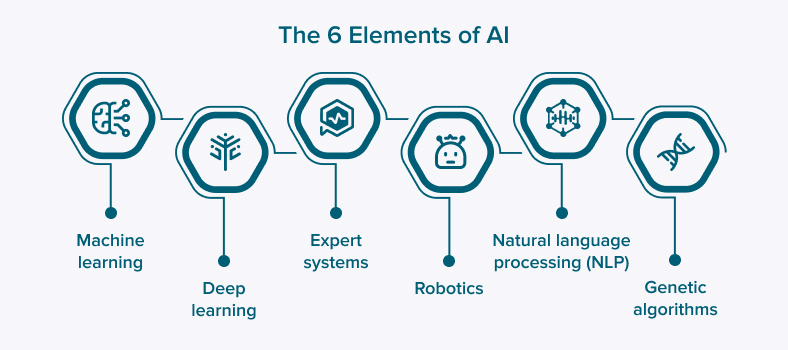
Meanwhile, this article uncovers the most common elements to help you understand the industry better. These elements (also referred to as subsets) of AI include:
- Machine learning;
- Deep learning;
- Expert systems;
- Robotics;
- Natural language processing (NLP);
- Genetic algorithms.
You probably heard about some of the names in this list, but let’s cover what exactly they do.
Machine learning (ML)
Machine learning is a part of AI that provides it with the ability to automatically learn new information and improve its own performance over time. Thanks to machine learning, AI can discover patterns in data, automatically improve software performance, and design algorithms that allow systems to learn based on previous data.
ML is generally divided into three main types: supervised, unsupervised and reinforcement learning.
Supervised learning is a type of learning where AI is provided with labeled datasets in order to predict the output. Contrary, in unsupervised learning, the datasets provided are not labeled. In this case, AI needs to detect patterns independently and learn outputs from scratch.
Reinforcement learning is where the user gives a positive or negative reward based on AI performance. This method helps AI tools to learn which actions lead to positive rewards and encourages them to perform specific actions.
Deep learning
Deep learning can perform human-like tasks without human involvement. Generally, it’s used to mimic a human brain, which is crucial for technologies like self-driving cars or automatic translation. Engineers apply both supervised and unsupervised learning to train deep learning algorithms.
This subset requires a lot of data and computational power since it’s implemented through neural networks. However, this technology could be described as “high cost – high output”.
Expert systems
Similar to other elements, this one is focused on emulating human decision-making. Backed by a massive dataset in a specific field, it can solve complex problems with expert reasoning (rules) behind its actions.
The only constraint for such systems is the dataset’s knowledge. The more information the dataset has, the smarter the expert system is. Because of that, expert systems are focused only on one field, for example, science or programming.
Robotics
The main goal of robotics is to manufacture and design robots that can do more complex tasks. This allows AI to manipulate not only data but also physical objects.
Most people would assume we are still at the stage where all robots are purely mechanical with little to no code. But in reality, we already surpassed that point, and AI has come to robotics. Though this element is relatively new, we already saw its implementations and will see even more in the future.
Natural language processing (NLP)
NLP is an element that allows artificial intelligence to understand and manipulate human language in numerous usage scenarios. It processes datasets that contain text or human speech in order to understand the content and contextual nuances.
It consists of natural language understanding and natural language generation. Think of speech recognition, sentiment analysis (recognising tone of voice), machine translation, or chatbots – NLP is everywhere.
Genetic algorithms
These algorithms are inspired by natural selection and evolution. By copying these processes to AI, we can train it to solve optimization problems. What takes living organisms millions of years, AI can experience in a couple of minutes, coming up with the most efficient solution.
A great example of this technique in action is autonomous vehicle routing. By using genetic algorithms, vehicles go through thousands of possible routes in just seconds and come up with the most optimal one that will minimize travel time and fuel consumption.
Another example is supply chain management. Too hard for you to come up with the best production schedule and distribution routes? It’s easy for AI! By quickly going through each possibility, it will provide you with preferred options.
AI Mobile App Development Is a Trend for 2024
Bringing AI into the hands of regular consumers has left a very positive response over the years. A lot more startups and big companies decided to implement AI in their products, especially mobile apps.
We see the AI app sector forecasts annual revenue to be 11,3 billion USD by the end of this year. In addition to this, mobile app consumer spending worldwide is projected to be 139 billion USD in 2024, reaching 185 billion USD in 2027.
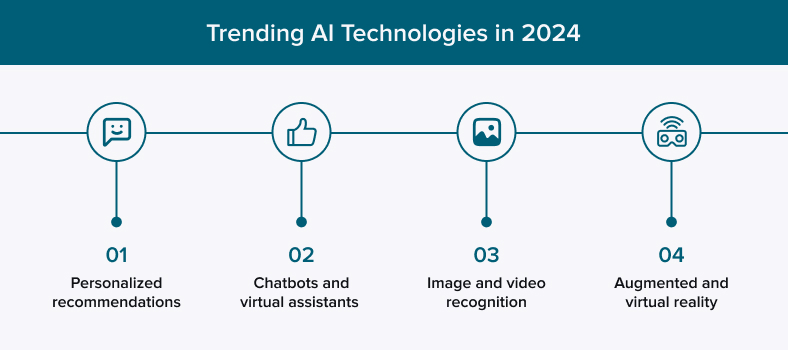
With each new iteration of AI, the technology behind it becomes more beneficial for companies and users at the same time. You can see these mobile AI implementations pretty much everywhere:
- Personalized recommendations;
- Chatbots and virtual assistants;
- Image and video recognition;
- Augmented and virtual reality.
Let’s cover them one by one starting with personalized reccomendations. Ever wondered how your apps know exactly what you will be interested in? That’s because artificial intelligence algorithms analyzed your past in-app behavior and formed recommendations for you individually.
Chatbots and virtual assistants have already been in our lives for a couple of years now, and their popularity isn’t going anywhere. It’s no wonder, since virtual assistants are so helpful when it comes to reminding you things or controlling your smart home with voice commands.
Image and video recognition are probably the most helpful AI features for mobile apps that can capture your face and generate an avatar during video calls or for photos. Or maybe you don’t feel like wearing makeup today so you just put on a filter with makeup on.
Augmented and virtual reality are technological breakthroughs on their own. But if we combine them with artificial intelligence, the results will lead us to more immersive and interactive experiences. For example, test how an accessory or a piece of clothing would look on you without even putting them on – all thanks to AI that provides realistic product depictions.
To summarize, AI mobile apps have already been in use for quite some time and according to revenue statistics of the mobile app market, this trend will see even more growth in the next couple of years. Intelligent technologies are here to stay for a very long time, so why not take this opportunity and create your own AI mobile app?
What Are the Benefits of Implementing AI in Mobile Apps?
The rapid development of AI technologies gives vast possibilities for transforming the mobile experience. Today, many apps provide AI-enhanced features for learning languages, getting new contacts, choosing what to cook for dinner, and unlocking devices with biometrics. With AI, mobile apps become more engaging, exciting, and empowering.
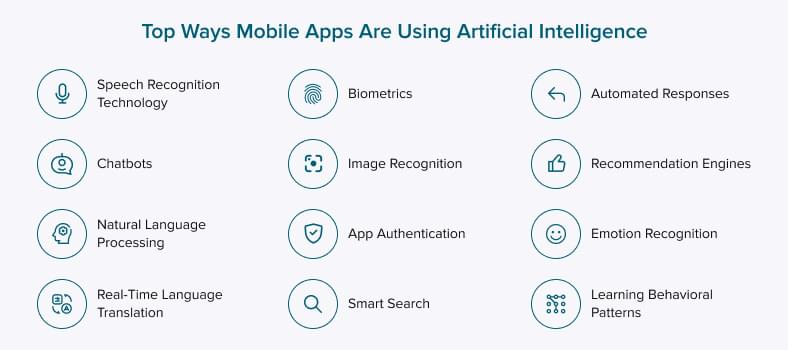
As mobile apps with AI-enhanced functionality appeal to users, businesses can utilize their emotional power to achieve numerous benefits.
The advantages companies can gain vary a lot. We can categorize them as follows:
- Improved user experience through deep personalization of content, ads, and recommendations.
- Automation of day-to-day tasks helps reduce costs and decrease the chance of human-made mistakes.
- Increased efficiency in operations, data processing, and customer support.
- New revenue stream opportunities due to better recommendations and consumer satisfaction.
- Enhanced security of sensitive data and mobile apps in general.
Our experience proves that adopting AI to a mobile app naturally increases brand awareness and perception. Users like and warmly greet innovative, smart, and intuitive apps that understand them and serve their needs better.
Successful Use Cases of AI Mobile Apps: CHI Software Experience
There are no two businesses alike, so AI adoption is always a one-of-a-kind story. We as an AI app development company have built AI mobile apps from scratch and added AI-powered features to working apps. And every time, it is a unique and exciting experience.
Chatbot Powered by the GPT Model
Choosing an internet plan can be boring, but discussing options with a penguin is fun. Therefore, our client, an internet and mobile communication provider, decided to opt for AI chatbot app development services. The project’s main goal was to introduce a cartoon-like character as a client support assistant.
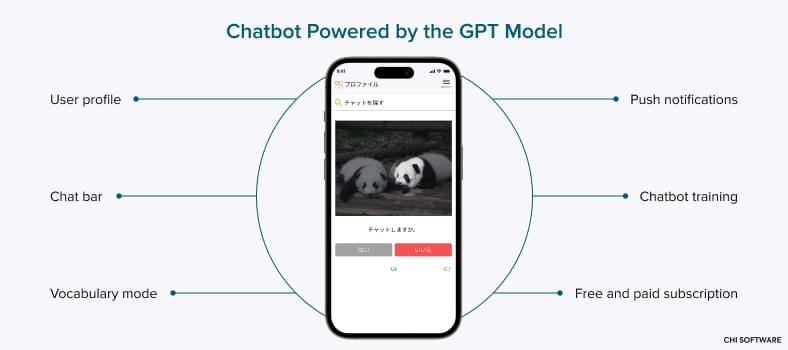
We created an entertaining mobile app with an emperor penguin named Kopenchan. Based on the Tamagochi principle, the penguin can evolve, learn new words, and use them in communication.
Kopenchan is trained to interact with clients, using previous context from a chat history, respond to client requests, and announce the company’s updates and newsworthy events through push notifications.
Though the penguin chatbot looks like an entertaining app addition, it has had a significant positive impact on business metrics. The client reports increased customer satisfaction and better engagement, as well as operational cost savings of up to 20% due to customer support automation.
Computer Vision Solution with a Recommendation System
Getting expert advice while choosing skincare and beauty products is essential for many shoppers.
In an ideal world, a beauty expert should keep up with the market’s latest trends and quickly and carefully identify consumer needs. She or he should make personalized and judgment-free recommendations, considering clients’ preferences and product availability. But who could it be? AI is the guy!
To help shoppers make buying decisions, our client, a cosmetic retailer from the US, decided to turn to an AI-powered mobile app development company. It should analyze customers’ selfies, examine their needs, and recommend products that serve them best.
In response to these requirements, CHI Software developed a mobile app based on Computer Vision, photo face recognition, and ChatGPT capabilities.
Workflow in more detail
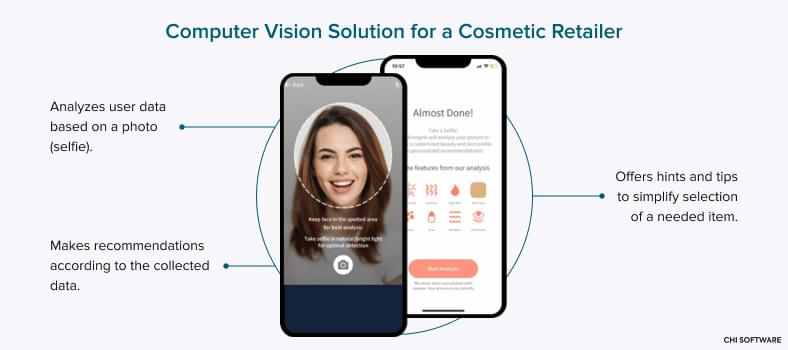
So how does it work? First, a person takes a selfie with the app. Then, the AI-based mobile app identifies a face in the photo and analyzes it. Generally speaking, the app compares the image to numerous samples in its huge library to specify the problem and find possible solutions. Users can give more information by text or voice to achieve better results.
Based on the data received, the app generates personalized recommendations. ChatGPT-based chatbot wraps all the useful data in a friendly chit-chat with a user. This way, a person can express concerns and doubts and receive more detailed explanations. The app also collects feedback to improve the model for more satisfying results in the future.
After the solution went live, the retailer reported improved customer loyalty, optimized inventory management, and an increase in sales (+10%) and revenue thanks to upselling and cross-selling.
Tech Stack for AI Application Development

Of course, there is no universal tech stack that fits every case of AI mobile app development. Our team determines the technologies for any project exclusively, considering requirements, desired features, and best development practices. So, how to make an AI app?
Programming Languages, AI Platforms, and Libraries
Most artificial intelligence applications you see in the world were written in one of these programming languages. Let’s take a look at them one by one:
- Python.
Python is considered a great programming language for beginners. But being simple to understand isn’t the only strong side of it. It is also a powerful tool for data analysis, with a great number of libraries to analyze and classify large datasets, making it perfect for AI solutions.
- Java.
Java is one of the most popular programming languages out there, so it’s no wonder programmers use it in AI development. On top of its simple debugging and maintenance, Java is multi-platform, which is great for mobile app development. Actually, most mobile apps are written on Java, and that includes AI-based applications.
- C++.
The biggest advantage of C++ is its speed and efficiency. Since many AI applications are complex, using a programming language that can execute code fast will improve the speed of AI processing. At the same time, speed and efficiency come with a complex code structure.
These are the most popular programming languages. However, in some cases, engineers can also turn to C#, R, Lisp, or Prolog.
To optimize development costs, our software engineers use third-party AI and Machine Learning (ML) platforms, including the most popular ones:
- Google TensorFlow is an innovative data science environment for numerical computation using dataflow graphs and creating AI-based projects from idea to launch. The functional and portable TensorFlow has a flexible architecture that allows computing to be deployed across multiple processors applying a common API.
- Microsoft Azure. The platform’s advantages are a wide range of algorithms, advanced analytical mechanisms, and high-quality multilingual documentation. AI/ML capabilities include predictive modeling, recommendations mechanism, natural language processing, pattern recognition, and other services.
- Amazon AWS helps to create, train, and deploy models and intelligent apps of any complexity. The platform is based on simple, scalable, and flexible ML technology, which is used, among other prominent engineers, by scientists from the Amazon community.
Other trustworthy AI platforms include IBM Watson, Oracle AI cloud services, Mendix low code platform, H2O, and Wit.ai.
Frameworks and Application Programming Interfaces (APIs)
AI, ML, and deep learning frameworks greatly simplify the development of complex, high-tech products and allow you to use third-party functionality. The most popular options are:
- Microsoft Cognitive Toolkit (CNTK) helps create various ML models, including recurrent and convolutional neural networks. Using the framework, we quickly process arrays of unstructured data, choose metrics and algorithms, and train machines to think almost like people.
- AWS Machine Learning assists in the development of highly complex applications with high performance. It can connect applications to cloud services and create forecasts using API.
- PyTorch. Combining the ML library, pre-trained models, and scientific computing structure, it allows us to quickly build complex systems such as deep neural networks. The Python-powered framework provides excellent flexibility and efficiency.
- Core ML/Create ML are well-suited for developing AI products for Apple devices in particular.
- Caffe2 helps build modular deep learning environments. ML’s open-source set of algorithms enables engineers to experiment with different models.
Other popular framework options are Keras, Accord.NET, scikit-learn, and SparkMLlib. Apart from frameworks, we use third-party APIs and software development kits (SDKs) )to speed up and optimize software development. The options include Azure Text Analytics API, Microsoft Face API, Google Vision API, Apple SiriKit, and others.
How to Build an Artificial Intelligence App: Key Steps
Though some of the steps are repeated many and many times while developing an AI app, we follow the basic pipeline:
- Discovery, requirements definition, and planning
- Model learning
- Minimum viable product (MVP) and final app development
- Delivery and further maintenance.
Let us guide you through the details of every stage of how to make an AI app.
1. Discovery, requirements definition, and planning
To understand how to build an AI app, we need to identify the issue first: decompose the problem and possible solutions, learn more about target users, discover market conditions and competitors, and identify desired outcomes. The discovery phase depends on the client’s requirements, information on hand, and available documentation.
Once the idea and problem are defined, we create a clear list of product requirements. Properly written and structured, they help developers understand the purpose of creating a product and identify technologies and tools for working.
At the planning stage, we also:
- determine a team of technical and non-technical specialists,
- draw up a work schedule,
- start exploring the data required to create an AI/ML model.
2. Model learning
In order to build an AI app, it is required to have large amounts of well-prepared structured data to operate correctly. Therefore, software engineers carefully study input information and its sources, following the Cross-Industry Standard Process for Data Mining (CRISP-DM).
Next, we check input data for errors, missing values, or incorrect labels and move on to the data preparation stage, which requires:
- Selecting and uploading raw data,
- Picking annotation tools,
- Highlighting and labeling data blocks,
- Selecting and saving file formats.
The collected dataset allows us to compare solution options and proceed with the modeling stage. The previously collected data is used to train ML models via various methods. When the model is trained, we have to evaluate whether it is ready for deployment or needs further training. Once we have a model deployed, we integrate it into a mobile app.
3. MVP (Minimum Viable Product) and full-fledged AI-based app development
AI development projects at CHI Software are based on the Agile methodology. It means conducting many cycles of software development and testing one after another. This way, we can find gaps as early as possible and fully control the product’s high quality and market relevance. We are gradually moving from a minimum viable product (MVP) to a final solution to be presented to end users.
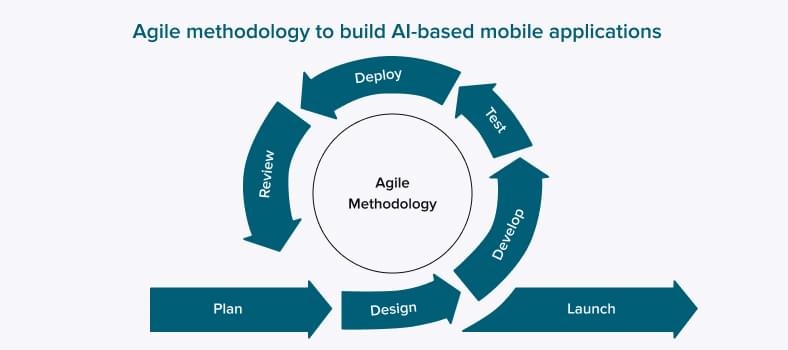
An MVP allows us to present a basic product version to evaluate essential functionality along with the overall viability of the app’s idea. In general, creating an AI-driven application is no different from a typical software development life cycle (except for CRISP-DM), so we have to:
- think over the solution’s architecture,
- design a user interface and user experience,
- work on the frontend and backend parts (user interface development and server-side development).
At the development stage, we optimize the app’s performance, improve and expand functionality, and adapt the product to mobile OS updates.
4. Delivery and maintenance
When our system is ready, we can deliver it or publish the application on app stores. For native apps, we use the Play Market guide for Android applications and AppStore recommendations for iOS products.
We strongly recommend updating the system regularly (so that it supports the latest OS versions) and improving models by adjusting and supplementing the previously collected data.
How Much Does It Take to Build an AI Mobile App? Time and Budget Explained
AI app development cost depends on many factors, such as features implemented, product complexity, a tech stack, and the number and rates of people involved. Budgets to build a chatbot and a corporate data analysis system are strikingly different. However, there are general rules to consider.
The cost of an AI mobile app correlates with the time of tech and non-tech specialists involved. Here is our rough estimate of the time to build an AI mobile app:

From our experience, it takes about three months to develop a simple AI app. However, if we talk about an end-to-end solution with rich functionality, it will take about twice as long. Extra factors, such as data visualization, the minimum accuracy rate for predictions, and dashboard requirements, can add to the time and, therefore, the cost of development.
AI app development cost revealed
In general, developing AI software can cost at least 10,000 USD, but in most cases, budgets range from 30,000 USD to 100,000 USD, depending on the product’s size and complexity.
Product support is another unavoidable part of AI app development cost, which represents around 30 percent of the development budget for the first year post-launch and 15-25 percent per year afterward.
Integration of Artificial Intelligence in Your Industry
Now that we know how to build AI apps, the question arises whether businesses in your field could benefit from AI. This part will give you the answer. By covering the biggest industries, we want to give you an idea of what to expect. Let’s start with healthcare.
Healthcare

This industry has seen the most benefits from artificial intelligence implementation. Not only it helps improve patient experience, but also increases efficiency and saves lives in the process.
Faster applying process, as well as better management and treatment of patients are the first improvements any client will notice. From less invasive surgeries to medication errors – technologies can cover it all! One of the most fascinating use cases of AI in healthcare we saw during Covid pandemic, when an AI tool designed a vaccine.
This is why artificial intelligence continues to evolve in this industry. Soon enough, we expect a treatment plan fully created by AI or diagnosing medical problems based on the X-ray images and scans.
Manufacturing
When it comes to manufacturing, the first AI implementation you could think of is automation. But that only scratches the surface of the tech potential in this field.
AI is also a key to improving quality control process or supply chain optimization, and it can even predict potential equipment failures. By implementing it into manufacturing alongside your regular workforce, you will notice an increase in productivity caused by the synergy of computer efficiency and human critical thinking and creativity.
Artificial intelligence can even manage the whole factory mostly on its own. For example, Philips has a factory in the Netherlands with only nine human workers. Or Adidas pioneered 3D-printed footwear.
In the future, we can expect even more AI involvement in manufacturing, resource optimization, energy efficiency and better recycling.
Finance
AI is creating a more robust financial operating system by automating traditionally manual banking processes and enabling better understanding of financial markets.
Technologies can make trades in real time with the speed never seen before. By conducting deep market analysis in seconds, it can provide insights and dictate where to make your next investment. But that’s not all from AI.
Managing your personal finances or finances of your company or market analysis – AI can do it all with little to no effort. Who wouldn’t want such a powerful tool on your side? Some banks have already started implementing AI in their work process.
Logistics

The main bottleneck of logistics usually comes down to determining the most efficient route. This is something AI is very proficient at. However, it’s not the only use for AI.
Inventory management, delivery schedules, fleet optimization, and even demand forecasting can all be covered by artificial intelligence. All this leads to better decision-making in supply chain operations, which guarantees cost savings and improved productivity. A great use case of AI in logistics is Valerann’s Smart road system.
Cyber security
While risks are rising, cyber security adds a new tool to the data protection arsenal – artificial intelligence. AI systems enable automatic threat detection, as well as generate alerts and identify potential phishing attacks. It can also prevent malware from exploiting vulnerabilities of your systems.
With focus on protecting sensitive data, some of the AI technologies become increasingly crucial, for example, NLP and deep learning. Any customer would want self-learning, constantly evolving defenses that are tougher to crack than any other means of protecting data out there.
AI-assisted cyber security could sound like some product of fiction, but in reality it has been made already.
We have covered the main industries that use AI. Granted, that’s not the only industries that are improving their businesses with innovations. Algorithms are successfully implemented in retail and e-commerce, media & entertainment, travel & tourism, and so on.
In other words, AI applications will help you stay on top of your competition in any field you are working on. Contact the CHI Software team if you want to learn more about how AI can be beneficial for your business in particular!
Conclusion
Artificial intelligence has been landing on mobiles. AI app development solutions help people be more productive, creative, and efficient in their daily chores and activities, so unsurprisingly, AI is warmly greeted by mobile users.
We have also covered how to build an AI application. Adding AI features to your mobile app is a great way to overdo the competitors and gain a market advantage. Who would not want that?
To understand the latest AI trends and reach your goals right away, you need a professional AI app development services. The expertise of experienced software developers and business analysts can work miracles. So get the ball rolling!
Book your free consultation right now! Regardless of the size and available budget, we will help your business idea stand out.
FAQs
-
Is it possible to make an app with AI?
Sure! You can use a special AI-powered app builder with ready-made features or create a solution from scratch with the help of professional developers. Each approach has pros and cons and should be considered individually.
-
What is an AI application?
An AI application is a mobile tool that uses AI capabilities to perform a part or all of its tasks.
-
What is AI mobile app development?
It is a process of developing applications with artificial intelligence features, which, among other things, allow companies to create a previously unachievable user experience.
-
How much does AI app development cost?
The minimal budget to build an AI app is 10,000 USD, but generally, the cost is between 30,000 USD and 100,000 USD and heavily depends on software requirements and desired business results.
-
What is the best AI app development company?
There is no perfect AI company for every business. The final decision depends on your budget, corporate culture preferences, and even team mentality.
We suggest you pay attention to the vendor’s successful use cases and process transparency. CHI Software, for example, has been developing AI for various industries. We are also an ISO-certified company prioritizing data security on every project. -
What are the best AI apps?
AI apps usually serve different industries and niches, so it is better to determine the best solution in a particular category. For example, it is eBay in retail, Cleo in fintech, Spotify in media & entertainment, ELSA Speak in education, etc.
The success of any AI app relies on algorithm abilities. It should be trained on the well-structured app data, considering every user maneuver within an app. Training a robust algorithm, as a rule, takes some time, so the longer you work in the niche, the more intelligent your app becomes.

Alex is a Data Scientist & ML Engineer with an NLP specialization. He is passionate about AI-related technologies, fond of science, and participated in many international scientific conferences.

